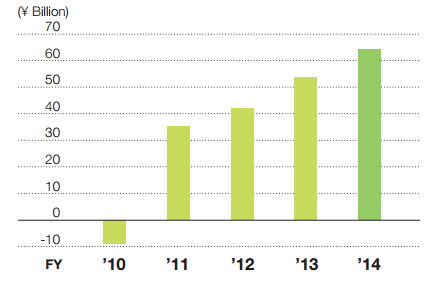Toyota SWOT Analysis
SWOT is an acronym for strengths, weaknesses, opportunities and threats related to organizations. You can learn the theory of SWOT analysis here. The following table illustrates Toyota SWOT analysis:
| Strengths 1. Solid financial position
2. Toyota Production System (TPS) 3. Advanced technological features and capabilities 4. Leadership position and brand value |
Weaknesses 1. Extensive dependence on Japan and North American markets
2. Passenger safety issues in the past and product recalls 3. Weak presence in emerging markets 4. Lack of flexibility due to large size |
| Opportunities 1. Investments in automated driving technology
2. Business diversification 3. Focus on developing countries 4. Further concentration on electric cars |
Threats 1. Passenger health and safety issues
2. Fluctuations in the prices of fuel 3. Emergence of innovative competitors 4. Increase in the prices of raw materials |
Strengths
1. Generating revenues of ¥25.6919 trillion, which is an increase of ¥3,627.7 billion, or 16.4%, compared with the prior fiscal year,[1] Toyota possesses massive financial resources. As it is illustrated in Figure below, amid intensifying competition and increasing global economic uncertainly, the net operating income of Toyota has been consistently increasing for the last five years. The current solid financial position of the company contributes to its competitive advantage via granting opportunities to engage in research and development to a greater extent.
Changes in Toyota’s net operating income[2]
2. Toyota Production System (TPS) is a widely recognized system for its efficiency in elimination of waste, irregularities, and overburdening from the production process. Based on two fundamental concepts of jidoka (automation with a human touch) and Just-in-Time principle, this system has enabled Toyota to adopt a proactive approach in dealing with manufacturing issues, at the same time saving significant manufacturing costs. Additionally, Toyota has introduced and perfected manufacturing concepts of Kaizen (continuous improvement) and Genchi Genbutsu (on-site, hands-on experience) to gain competitive advantage on the efficiency of manufacturing.
3. Toyota vehicles are usually equipped with advanced information and communication technologies as part of company’s aim to create ‘Smart Mobile Society’. Particularly, ‘T-Connect’ service developed by Toyota “features software agents that control car electronics, search for information, and display pertinent information for a safe and comfortable driving experience”[3]. Increasing technological integration to advance features and capabilities of vehicles is one of the solid sources of Toyota’s competitive advantage.
4. Valued at USD 28.9 billion according to the BrandZ Top 100 Most Valuable Global Brands 2015 study[4], Toyota is the most valuable brand in the world in automobile industry. Leadership position of brand value is a considerable strengths in terms of ensuring the consumer perception of confidence about the future of the company with positive implications on consumer purchase behaviour.
Weaknesses
1. For the fiscal year of 2014, Toyota’s primary markets on the basis of vehicle unit sales are Japan (26%), North America (28%), Europe (9%) and Asia (18 %).[5] The majority of Toyota vehicles (54%) are sold in Japan and North America and an extensive dependence on only these two markets for 64.1% of company revenues can be specified as a noteworthy weakness of the business. Specifically, due to the dependence on only two markets, Toyota financial performance is vulnerable to macroeconomic and other issues in Japan and North America.
2. Passenger safety issues and concerns and resulting product recalls in the past weakened the brand image to a considerable extent. One of the most recent and significant cases involve the recall of 6.5 million cars because of steering and seat problems in 2014. Since early 2012, the company recalled about 20 million vehicles because of the variety of issues. Moreover, in the previous period a faulty accelerator pedal had caused a recall of 10 million cars in 2009 – 2010.[6]
Detailed discussion of Toyota SWOT analysis and application of PESTEL, Porter’s Five Forces and Value Chain Analyses on Toyota can be accessed via purchasing Toyota Motor Corporation Report. The report also comprises an analysis of Toyota’s marketing strategy and company’s approach towards Corporate Social Responsibility (CSR).
[1] Annual Report (2014) Toyota Motor Corporation
[2] Annual Report (2014) Toyota Motor Corporation
[3] Annual Report (2014) Toyota Motor Corporation p.21
[4] Mihalascu, D. (2015). Cars Scoops, Available at: http://www.carscoops.com/2015/06/toyota-remains-most-valuable-auto-brand.html
[5] Annual Report (2014) Toyota Motor Corporation
[6] Rankin, J. (2014). The Guardian, Available at: http://www.theguardian.com/business/2014/apr/09/toyota-recalls-over-6m-cars-worldwide


